-
 Bitcoin
Bitcoin $106,754.6083
1.33% -
 Ethereum
Ethereum $2,625.8249
3.80% -
 Tether USDt
Tether USDt $1.0001
-0.03% -
 XRP
XRP $2.1891
1.67% -
 BNB
BNB $654.5220
0.66% -
 Solana
Solana $156.9428
7.28% -
 USDC
USDC $0.9998
0.00% -
 Dogecoin
Dogecoin $0.1780
1.14% -
 TRON
TRON $0.2706
-0.16% -
 Cardano
Cardano $0.6470
2.77% -
 Hyperliquid
Hyperliquid $44.6467
10.24% -
 Sui
Sui $3.1128
3.86% -
 Bitcoin Cash
Bitcoin Cash $455.7646
3.00% -
 Chainlink
Chainlink $13.6858
4.08% -
 UNUS SED LEO
UNUS SED LEO $9.2682
0.21% -
 Avalanche
Avalanche $19.7433
3.79% -
 Stellar
Stellar $0.2616
1.64% -
 Toncoin
Toncoin $3.0222
2.19% -
 Shiba Inu
Shiba Inu $0.0...01220
1.49% -
 Hedera
Hedera $0.1580
2.75% -
 Litecoin
Litecoin $87.4964
2.29% -
 Polkadot
Polkadot $3.8958
3.05% -
 Ethena USDe
Ethena USDe $1.0000
-0.04% -
 Monero
Monero $317.2263
0.26% -
 Bitget Token
Bitget Token $4.5985
1.68% -
 Dai
Dai $0.9999
0.00% -
 Pepe
Pepe $0.0...01140
2.44% -
 Uniswap
Uniswap $7.6065
5.29% -
 Pi
Pi $0.6042
-2.00% -
 Aave
Aave $289.6343
6.02%
Should we run when the KD indicator diverges? How to verify the accuracy?
The KD indicator helps crypto traders spot overbought or oversold conditions, with divergence signaling potential trend reversals when price and momentum move oppositely.
Jun 16, 2025 at 05:14 am
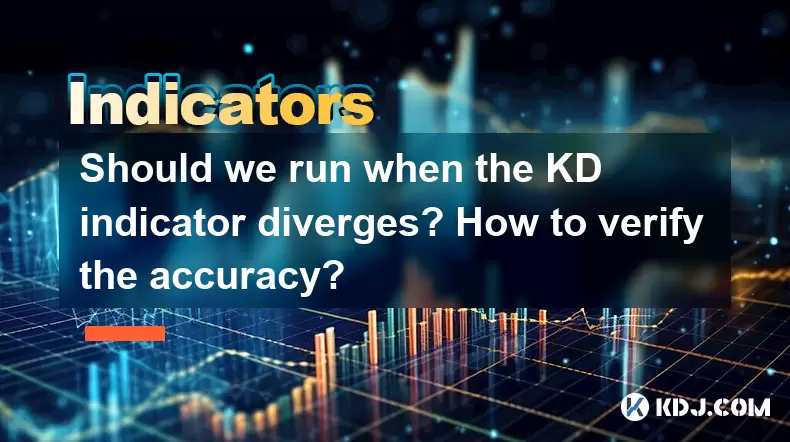
Understanding the KD Indicator in Cryptocurrency Trading
The KD indicator, also known as the stochastic oscillator, is a momentum-based technical analysis tool widely used in cryptocurrency trading. It consists of two lines — the K line and the D line — which help traders identify overbought or oversold conditions. The primary function of the KD indicator is to signal potential reversals by comparing a cryptocurrency's closing price relative to its price range over a specified period, typically 14 days.
In crypto markets, where volatility is high and trends can reverse rapidly, understanding how the KD indicator works becomes crucial for decision-making. Traders often look for divergence between price action and the KD lines to anticipate trend exhaustion or reversal points.
What Is Divergence in the KD Indicator?
Divergence occurs when the price of a cryptocurrency moves in one direction while the KD indicator moves in the opposite direction. This discrepancy suggests that the current trend may be losing strength and could soon reverse. There are two main types of divergence:
- Bullish divergence: When the price makes lower lows but the KD indicator makes higher lows.
- Bearish divergence: When the price makes higher highs but the KD indicator makes lower highs.
For example, if Bitcoin reaches a new high but the KD line fails to surpass its previous high, this indicates weakening momentum. Such bearish divergence might prompt traders to consider exiting long positions or preparing for a short opportunity.
Should You Run (Exit) When KD Divergence Occurs?
Deciding whether to exit a position based solely on KD divergence depends on several factors. While divergence can signal a potential reversal, it is not a guaranteed sell or buy signal. Many experienced traders avoid making impulsive decisions based only on divergence because false signals are common in highly volatile crypto markets.
Instead of immediately running, traders should evaluate other confirming indicators such as volume, moving averages, or candlestick patterns. For instance, if volume drops significantly during an uptrend despite rising prices, it strengthens the bearish divergence signal from the KD indicator.
Moreover, time frame matters. A divergence observed on a 1-hour chart may not carry the same weight as one seen on a daily or weekly chart. Hence, it’s essential to assess the context before deciding to exit or adjust your position.
How to Verify the Accuracy of KD Divergence Signals
Verifying the accuracy of KD divergence signals requires backtesting and multi-indicator confirmation. Here’s a step-by-step process to validate these signals effectively:
- Use multiple time frames: Examine the divergence across different time frames to confirm consistency. If divergence appears on both the 4-hour and daily charts, the signal gains more credibility.
- Combine with RSI or MACD: Use the Relative Strength Index (RSI) or Moving Average Convergence Divergence (MACD) to cross-verify whether similar momentum shifts are occurring.
- Check volume patterns: A divergence accompanied by declining volume increases the probability of a trend reversal.
- Historical backtesting: Analyze past instances where KD divergence occurred and observe how the price reacted afterward. Tools like TradingView allow users to draw historical divergence lines and review outcomes.
- Wait for confirmation candles: Look for bearish candlestick patterns like engulfing candles or shooting stars after a bullish divergence to strengthen the signal.
By applying these steps, traders can reduce false positives and improve the reliability of KD divergence as a trading signal.
Practical Steps to Apply KD Divergence in Crypto Trading
Implementing KD divergence into your trading strategy involves a structured approach. Below are practical steps to incorporate it effectively:
- Set up the KD indicator correctly: On platforms like Binance or TradingView, add the stochastic oscillator and set the default parameters (usually 14 periods).
- Identify swing highs and lows: Mark clear swing points on the price chart to compare with the KD values.
- Draw trendlines on KD lines: Draw trendlines connecting the peaks and troughs of the K and D lines to spot divergences visually.
- Compare price swings with KD swings: Ensure that you’re aligning the timing of price swings with corresponding KD swings to avoid mismatched comparisons.
- Mark divergence zones: Highlight areas where price and KD move in opposite directions for future reference and pattern recognition.
- Use alerts or notifications: Set up alerts on your trading platform to notify you when divergence forms on specific cryptocurrencies.
- Record observations in a journal: Keep a detailed log of each divergence event, including entry/exit points, trade outcome, and lessons learned.
These steps help create a repeatable process for identifying and acting upon KD divergence signals without relying solely on intuition.
Common Pitfalls and Misinterpretations of KD Divergence
Despite its usefulness, many traders misinterpret or misuse the KD divergence due to common pitfalls:
- Over-reliance on KD alone: Relying solely on KD divergence without confirming with other tools can lead to premature exits or missed opportunities.
- Ignoring market context: In strong trending markets, divergence may persist for extended periods without immediate reversal. For example, during parabolic Bitcoin rallies, the KD may remain overbought for weeks.
- Misalignment of time frames: Comparing a divergence on a 5-minute chart with a daily chart can result in conflicting signals.
- False divergences: Markets sometimes produce fake divergences that disappear once new price data invalidates the prior swing point.
- Late confirmation: By the time a divergence is confirmed, the price may have already moved significantly, reducing the reward-to-risk ratio.
Awareness of these pitfalls helps traders apply KD divergence more effectively and avoid costly mistakes.
Frequently Asked Questions
Q: Can KD divergence be used for all cryptocurrencies?
A: Yes, KD divergence can be applied to any cryptocurrency chart. However, its effectiveness may vary depending on the asset’s liquidity and volatility. Major coins like Bitcoin and Ethereum tend to provide more reliable signals compared to low-cap altcoins.
Q: How long does a KD divergence signal remain valid?
A: A KD divergence signal remains relevant until either a price reversal occurs or the divergence structure is invalidated by new price action. Typically, traders monitor these signals for up to 5–7 candles after formation.
Q: Is KD divergence more effective in bull or bear markets?
A: KD divergence tends to be more reliable in ranging or sideways markets. In strong trending environments, especially bull runs, divergence can give early or misleading signals. Therefore, traders should adapt their interpretation based on the prevailing market condition.
Q: What is the ideal setting for the KD indicator in crypto trading?
A: The standard setting is 14 periods, but some traders adjust it to shorter intervals (e.g., 7 or 10) for faster signals. However, shorter settings increase sensitivity and may result in more false signals in highly volatile crypto markets.
Disclaimer:info@kdj.com
The information provided is not trading advice. kdj.com does not assume any responsibility for any investments made based on the information provided in this article. Cryptocurrencies are highly volatile and it is highly recommended that you invest with caution after thorough research!
If you believe that the content used on this website infringes your copyright, please contact us immediately (info@kdj.com) and we will delete it promptly.
- 2025-W Uncirculated American Gold Eagle and Dr. Vera Rubin Quarter Mark New Products
- 2025-06-13 06:25:13
- Ruvi AI (RVU) Leverages Blockchain and Artificial Intelligence to Disrupt Marketing, Entertainment, and Finance
- 2025-06-13 07:05:12
- H100 Group AB Raises 101 Million SEK (Approximately $10.6 Million) to Bolster Bitcoin Reserves
- 2025-06-13 06:25:13
- Galaxy Digital CEO Mike Novogratz Says Bitcoin Will Replace Gold and Go to $1,000,000
- 2025-06-13 06:45:13
- Trust Wallet Token (TWT) Price Drops 5.7% as RWA Integration Plans Ignite Excitement
- 2025-06-13 06:45:13
- Ethereum (ETH) Is in the Second Phase of a Three-Stage Market Cycle
- 2025-06-13 07:25:13
Related knowledge

How to confirm the effectiveness of the average price line support in the time-sharing chart?
Jun 17,2025 at 12:56am
Understanding the Time-Sharing Chart and Its RelevanceIn cryptocurrency trading, time-sharing charts play a crucial role in analyzing short-term price movements. These charts typically display price fluctuations over a specific period, often ranging from minutes to hours. Traders rely on them to make quick decisions based on real-time data. The average ...

What does it mean when the momentum indicator breaks above the zero axis?
Jun 17,2025 at 12:43am
Understanding the Momentum IndicatorThe momentum indicator is a technical analysis tool used to measure the speed or velocity of price movements in cryptocurrency markets. It helps traders identify potential trend reversals, overbought or oversold conditions, and confirms existing trends. The indicator typically oscillates around a zero line, with value...
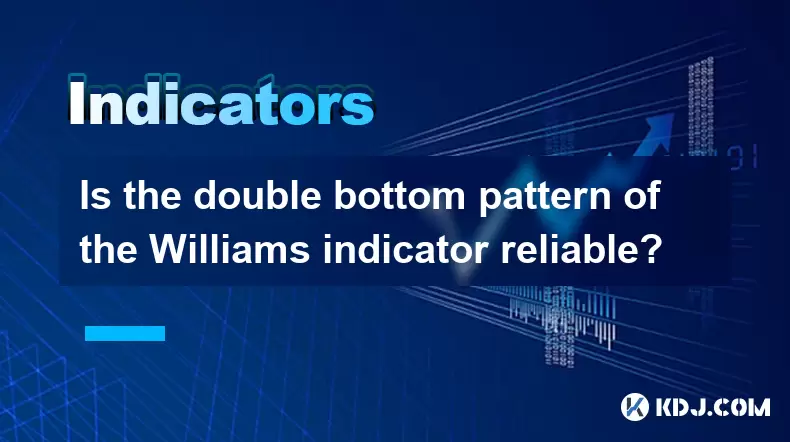
Is the double bottom pattern of the Williams indicator reliable?
Jun 17,2025 at 03:56am
Understanding the Williams Indicator and Its SignificanceThe Williams %R indicator, often referred to as Williams Percent Range, is a momentum oscillator used in technical analysis to identify overbought or oversold conditions in the market. Developed by Larry Williams, this indicator fluctuates between 0 and -100, with readings above -20 indicating ove...
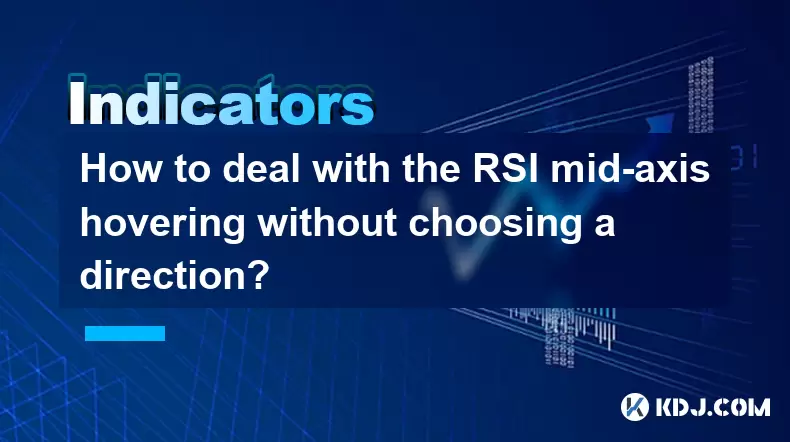
How to deal with the RSI mid-axis hovering without choosing a direction?
Jun 17,2025 at 02:02am
Understanding RSI Mid-Axis Hovering in Cryptocurrency TradingThe Relative Strength Index (RSI) is a popular momentum oscillator used by traders to assess whether an asset is overbought or oversold. In cryptocurrency markets, it's common for the RSI to hover around its mid-axis, typically at the 50 level, without showing a clear upward or downward trend....
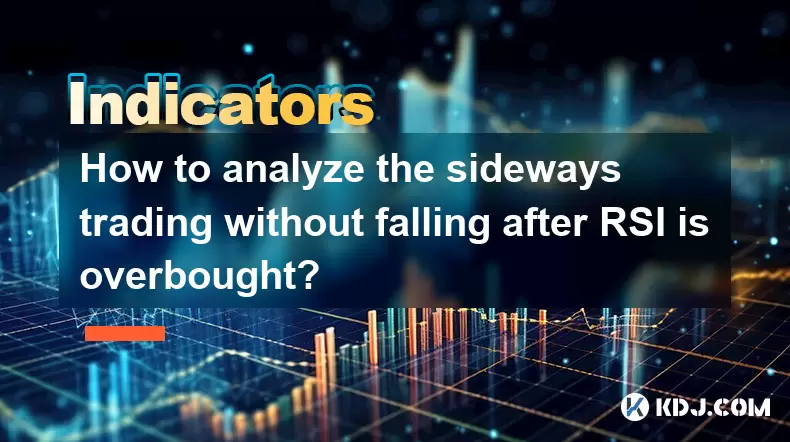
How to analyze the sideways trading without falling after RSI is overbought?
Jun 17,2025 at 04:14am
Understanding RSI and Its Role in Cryptocurrency TradingThe Relative Strength Index (RSI) is a momentum oscillator used to measure the speed and change of price movements. In the context of cryptocurrency trading, it helps traders identify potential overbought or oversold conditions. When the RSI exceeds 70, it typically signals that an asset may be ove...
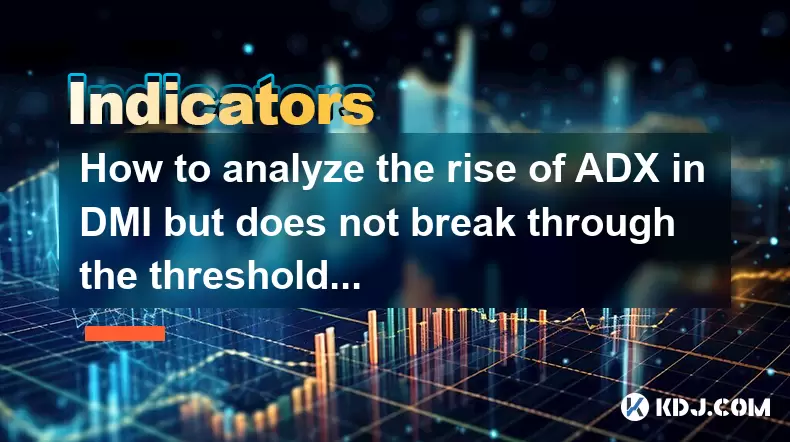
How to analyze the rise of ADX in DMI but does not break through the threshold?
Jun 16,2025 at 11:49pm
Understanding ADX and DMI in Cryptocurrency TradingIn cryptocurrency trading, ADX (Average Directional Index) is a technical indicator used to measure the strength of a trend. It works in conjunction with the DMI (Directional Movement Indicator), which includes two components: +DI (Positive Directional Indicator) and -DI (Negative Directional Indicator)...

How to confirm the effectiveness of the average price line support in the time-sharing chart?
Jun 17,2025 at 12:56am
Understanding the Time-Sharing Chart and Its RelevanceIn cryptocurrency trading, time-sharing charts play a crucial role in analyzing short-term price movements. These charts typically display price fluctuations over a specific period, often ranging from minutes to hours. Traders rely on them to make quick decisions based on real-time data. The average ...

What does it mean when the momentum indicator breaks above the zero axis?
Jun 17,2025 at 12:43am
Understanding the Momentum IndicatorThe momentum indicator is a technical analysis tool used to measure the speed or velocity of price movements in cryptocurrency markets. It helps traders identify potential trend reversals, overbought or oversold conditions, and confirms existing trends. The indicator typically oscillates around a zero line, with value...

Is the double bottom pattern of the Williams indicator reliable?
Jun 17,2025 at 03:56am
Understanding the Williams Indicator and Its SignificanceThe Williams %R indicator, often referred to as Williams Percent Range, is a momentum oscillator used in technical analysis to identify overbought or oversold conditions in the market. Developed by Larry Williams, this indicator fluctuates between 0 and -100, with readings above -20 indicating ove...

How to deal with the RSI mid-axis hovering without choosing a direction?
Jun 17,2025 at 02:02am
Understanding RSI Mid-Axis Hovering in Cryptocurrency TradingThe Relative Strength Index (RSI) is a popular momentum oscillator used by traders to assess whether an asset is overbought or oversold. In cryptocurrency markets, it's common for the RSI to hover around its mid-axis, typically at the 50 level, without showing a clear upward or downward trend....

How to analyze the sideways trading without falling after RSI is overbought?
Jun 17,2025 at 04:14am
Understanding RSI and Its Role in Cryptocurrency TradingThe Relative Strength Index (RSI) is a momentum oscillator used to measure the speed and change of price movements. In the context of cryptocurrency trading, it helps traders identify potential overbought or oversold conditions. When the RSI exceeds 70, it typically signals that an asset may be ove...

How to analyze the rise of ADX in DMI but does not break through the threshold?
Jun 16,2025 at 11:49pm
Understanding ADX and DMI in Cryptocurrency TradingIn cryptocurrency trading, ADX (Average Directional Index) is a technical indicator used to measure the strength of a trend. It works in conjunction with the DMI (Directional Movement Indicator), which includes two components: +DI (Positive Directional Indicator) and -DI (Negative Directional Indicator)...
See all articles

























































































